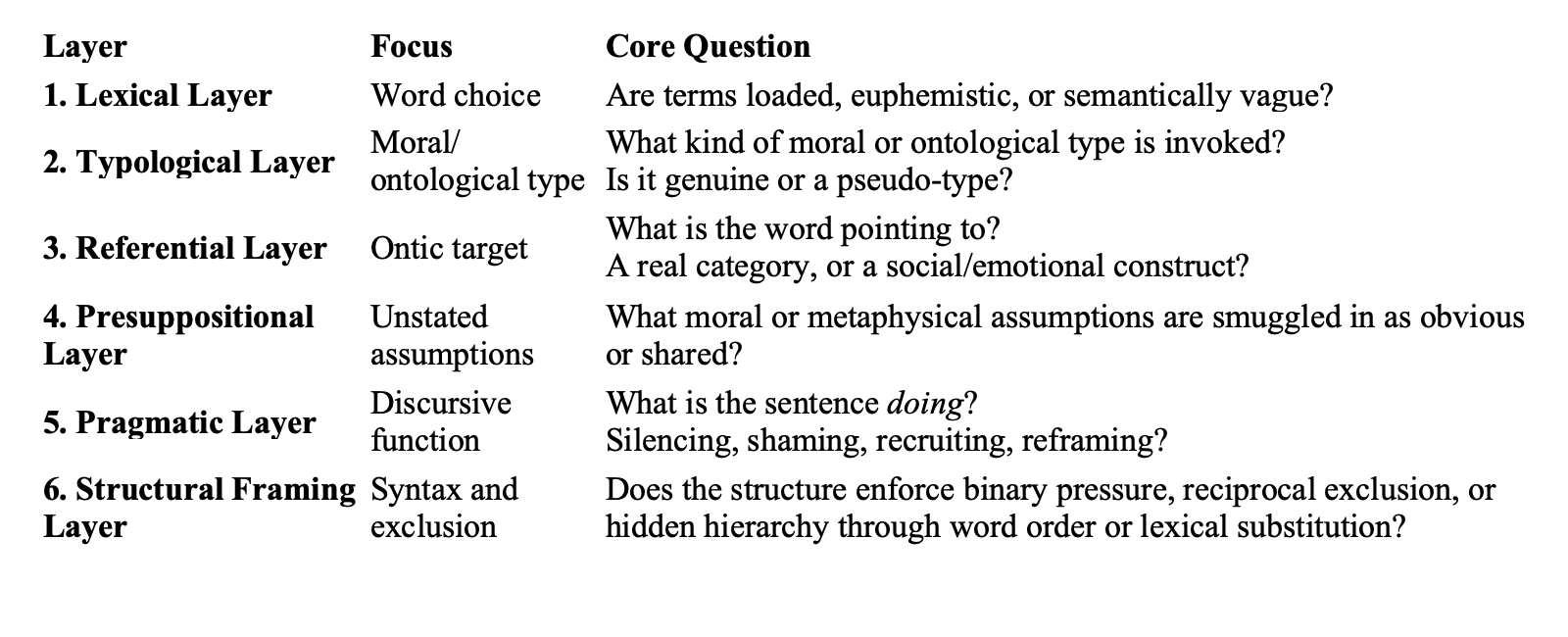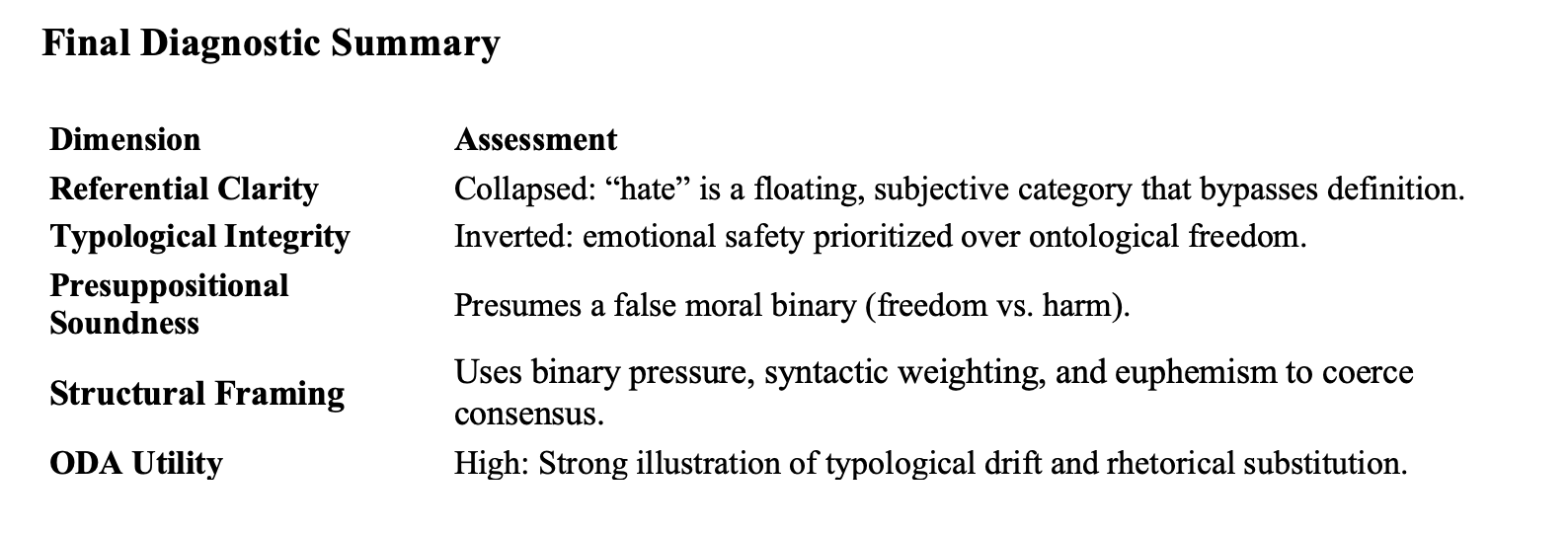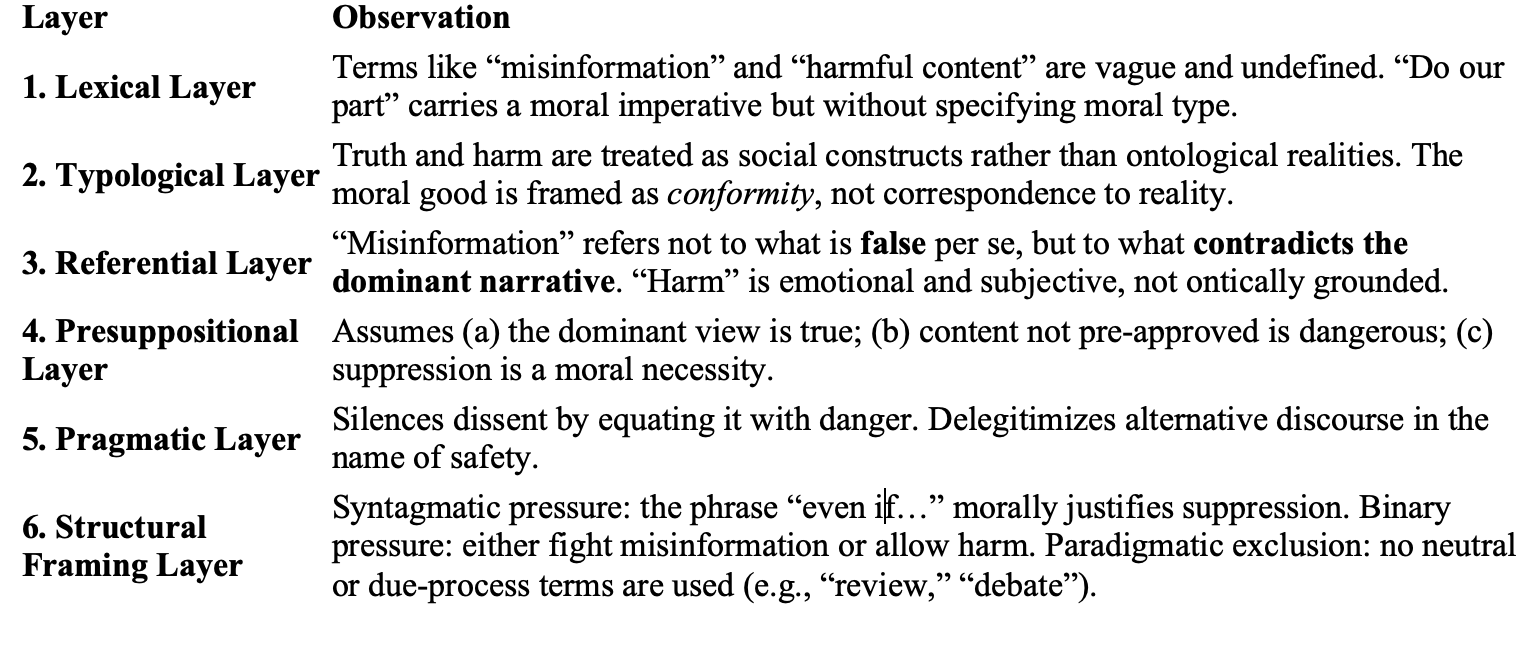Critical Discourse Analysis (CDA) emerged in the late 20th century through the work of Norman Fairclough, Teun A. van Dijk, and Ruth Wodak, aiming to unmask how language encodes and sustains power, ideology, and social inequality. It attends to framing, presupposition, lexical bias, and discursive exclusion—all of which remain diagnostically valuable.
However, CDA often presumes what it cannot ground: that oppression is wrong, emancipation is virtuous, and power redistribution is inherently just. These assumptions, while rhetorically potent, lack an ontological or moral foundation. CDA offers sharp critique but no transcendent anchor—its tools are incisive, but its foundations remain epistemologically untethered and morally relativized.
Earlier semiotic frameworks (influenced by Greimas, Eco, and others) sought to classify meaning through affective and relational structures—such as potency, affect, and valence. These offer a rudimentary analogue to MMAT, in that they describe how signs function emotionally or symbolically. Yet they lack both intentional accountability and typological discernment. They can trace what culture performs, but not what creation demands.
These earlier models cannot detect typophoric distortion, nor can they distinguish between true ontic reference and pseudo-instantiated tokens. In short, they describe semiotic behavior, but cannot expose ontological fraud.
In contrast, the Onto-Discursive Analysis (ODA) tool—rooted in a relational-submetaphysical framework—grounds its evaluation not in ideology, but in divine ontology. It does not merely critique language for how it distributes power, but assesses whether it:
corresponds to ontic reality,
aligns with God-instituted ontological types, and
preserves or violates relational and covenantal fidelity.
Where Critical Discourse Analysis begins with suspicion and deconstructs discourse in search of systemic bias, ODA begins with truth—treating speech as a morally charged act that either affirms or effigiates the created order.
The tool detects more than rhetorical asymmetry; it identifies:
Ontological drift – when tokens no longer correspond to true types.
Moral inversion – when evil is named as good, or falsehood as freedom.
Covenantal betrayal – when language simulates relational allegiance without grounding in divine truth.
Rather than treating language as a site of contest, ODA treats it as a site of discernment—a battlefield of typophoric conflict, where speech either reflects the Creator’s authority or participates in counterfeit instantiation. It does not ask, “Whose power is at work?” but rather, “Whose ontology is being affirmed or simulated?”
The Onto-Discursive Analysis (ODA) tool is not an arbitrary invention, nor a borrowed analytical model—it is the logical culmination of the entire relational-ontological framework. In a world saturated by reframed truths, pseudo-types, and rhetorical coercion, the need for an ontologically anchored method of discernment has never been more urgent.
This tool does not stand alone. It emerges organically from a larger theological architecture:
Ontology grounds all truth in the real—not in perception, consensus, or utility, but in what God has defined and delimited.
Epistemology follows—reframed not as abstract cognition, but as relational response to divine revelation.
Semiotics is clarified—where signs are not empty signifiers, but morally weighted tokens either aligning with or simulating ontological types.
Morpheme-level analysis (MMAT) evaluates how meaning is encoded within the smallest linguistic units—detecting effigiation, pseudo-instantiation, and typophoric distortion.
Pragmatics discerns how meaning is deployed—whether it functions covenantally or manipulatively in context.
ODA is the terminal application—the point at which all prior insights converge and are brought to bear on full discursive structures. Here, we assess whether a phrase, slogan, policy, or statement:
Upholds ontological integrity,
Reinforces typal clarity,
Embodies relational fidelity,
Or participates in distortion, drift, and covenantal betrayal.
ODA allows for real-time discernment—not merely detecting bias or power, but exposing the ontological status of discourse: whether it reflects reality as defined by God or simulates legitimacy under typological fraud.
The purpose of the Onto-Discursive Analysis (ODA) tool is to evaluate whether a given unit of discourse—be it a sentence, slogan, policy, or media excerpt—preserves ontological and moral integrity, or whether it conceals ontological drift, enforces pragmatic coercion, or simulates legitimacy through:
Lexical ambiguity – using morphemes or terms whose meanings are fluid or strategically blurred;
Pseudo-referents – invoking typologically ungrounded or fabricated categories (pseudo-types and pseudo-tokens);
Presuppositional sleight – smuggling illegitimate assumptions into the background of intelligibility;
Structural framing – sequencing or lexical selection that privileges certain interpretations while suppressing others;
Pragmatic moral coercion – employing emotional, institutional, or rhetorical pressure to simulate obligation or moral legitimacy (Modal-C without Modal-O).
The ODA tool makes such distortions visible—allowing the moral agent to discern not merely what is said, but what is smuggled, simulated, or suppressed.
This first layer evaluates the surface vocabulary of a discourse unit—examining whether words retain ontological fidelity or serve as vehicles for drift, inflation, or simulation.
Language carries historical, emotional, and cultural freight—but in manipulated discourse, terms are often redefined, euphemized, or inflated to obscure moral clarity and simulate legitimacy. This layer identifies such distortions by highlighting:
Loaded language — Morally charged but ontologically vague terms such as hate, justice, safe, or harm that signal affective or axiological weight without typological precision.
Euphemistic drift — The rhetorical softening of morally serious actions (e.g., termination of pregnancy for abortion; adjustment of rights for censorship), which suppresses ontological clarity through lexical substitution.
Semantic dilution — The broadening or stretching of terms to simulate universality, often detaching them from any concrete typological grounding (e.g., redefining violence to include speech).
Pseudo-technical jargon — Abstract, authoritative-sounding terms like disinformation, inclusivity, or misalignment, which evoke precision while concealing ideological construction and typophoric drift.
Diagnostic Focus:Are words being used with stable ontological referents, or are they pseudo-morphemes functioning as discursive tokens of manipulation? Do they preserve typological boundaries, or do they participate in effigiation, masking drift behind rhetorical force?
This layer evaluates what ontological or moral type a discourse unit invokes, assumes, or attempts to simulate.
In biblically grounded discourse, moral claims derive their legitimacy from stable, divinely instituted ontological categories—truth, justice, liberty, life, holiness. These are not constructed by consensus but revealed through covenantal relationship and divine prerogative.
Discourse drifts when it substitutes pseudo-types—terms that carry rhetorical weight and typophoric form, but lack revealed grounding. These pseudo-types operate as semiotic-typophoric projections: they mimic sacred categories while being socially fabricated, emotionally reinforced, or ideologically coded. This is an attempt to imitate the first half of the Double Prerogative (auctoritas essendi)—the divine authority to define kinds of being.
Yet the fraud deepens when pseudo-types are asserted as if they instantiate real presence. This move generates pseudo-tokens—discursive simulations of moral reality. Through naming, repetition, or institutional affirmation, the discourse acts as if it has enacted being (auctoritas instantiandi), despite lacking ontological warrant.
ODA identifies both phases of typological distortion:
The redefinition of kind (pseudo-type),
The simulation of ontic presence (pseudo-token).
Manipulative discourse frequently employs:
Emotional resonance (being heard replacing truth),
Sentimental inversion (love redefined as indiscriminate affirmation),
Idolatry of consensus, safety, or equality as pseudo-ultimate goods.
Does the discourse invoke a genuine ontological type, or a rhetorically elevated surrogate?Is the typological hierarchy preserved as defined by God, or inverted by cultural sentiment?
Typophora refers to linguistic or conceptual gestures toward ontological categories—such as justice, grace, or identity. These may function in two distinct ways:
Onto-typophoric reference: Gestures toward real types established by divine revelation. These references carry covenantal weight and are grounded in God's moral order.
Semiotic-typophoric (pseudo-typophoric) reference: Imitates the rhetorical structure of sacred language, but redirects it toward constructed or sentimental categories. These references simulate divine authority without ontological substance.
The ODA tool discerns when typophoric gestures are used to confer false legitimacy, anchor simulated morality, or invoke divine categories without revealed warrant.
This layer asks not merely what a word means, but to what it refers—its ontic grounding.
Discourse often employs floating signifiers—terms that lack a stable referent and shift meaning based on emotional context, institutional usage, or ideological coding. These words function not as pointers to reality, but as semantic tokensfor collective affect or rhetorical coercion.
In such cases, language invokes pseudo-referents: typophoric expressions like identity, truth, justice, or freedom which bear the form of onto-typophoric reference but are unmoored from revealed ontology. These are not acts of faithful naming, but of pseudo-instantiation—discursive assertions that simulate the Creator’s prerogative to speak being into existence.
This is an effigiated act: speech simulating presence where God has not authorized it.
Terms like hate, justice, or freedom used without definitional clarity, functioning as rallying banners rather than meaningful categories.
Redefined concepts such as gender, identity, or safety—treated as if they possess ontological fixity, yet fabricated through repetition, fiat, or consensus.
Does the word point to a real and divinely grounded referent?Or does it rely on affective consensus, cultural coercion, or institutional naming to simulate ontological legitimacy?
This layer diagnoses the unstated assumptions embedded within a discourse unit—the discursive givens that structure plausibility and restrict moral or intellectual dissent before any overt claim is made.
Presuppositions are often invisible yet powerful. They define the moral and epistemic boundaries of discourse, determining what is assumed to be reasonable, permissible, or even thinkable.
Common forms include:
“As we all know…” — presumes consensus, foreclosing dissent through rhetorical solidarity.
“Of course we must…” — implies necessity without revealed warrant, simulating ontological urgency through mere repetition.
“Those who disagree are…” — preemptively frames dissent as irrational, immoral, or deviant, assigning typological exclusion.
These techniques establish discursive inevitability, making it appear that only one “reasonable” or “moral” posture exists. Yet behind these cues lie smuggled assumptions—often pseudo-types masquerading as shared truths.
What assumptions are treated as morally self-evident, but are in fact ideological constructs?
What is being presupposed as typologically valid—without ever being grounded in ontological truth?
What pseudo-moral starting points are shaping the field of interpretation before any content is contested?
This layer enables the detection of discursive preconditioning—the attempt to control the moral and typological plausibility structure of discourse through subtle but forceful framing.
Discourse is never inert. Beyond propositional content, it acts—it positions the hearer, assigns roles, enforces allegiance, redirects focus, or disqualifies dissent.
This layer evaluates the moral function of speech in its pragmatic operation:Does it preserve moral agency, or constrain it?Does it serve relational fidelity, or discursive manipulation?
Examples of discursive acts:
Recruitment: “Join the movement.” — establishes moral allegiance as participation.
Silencing: “You don’t get to speak on this issue.” — denies moral standing or epistemic voice.
Shaming: “Only bigots would say that.” — disqualifies dissent through typological accusation.
Redirecting: “The real issue is not X, it’s Y.” — shifts interpretive priority, often to suppress ontological grounding.
Discourse manipulates when it simulates moral clarity not by illumination, but by coercing response—pressuring assent through affect, threat, or institutional scripting.
What moral posture does the discourse invite or demand?
Is it appealing to conscience and truth, or bypassing moral deliberation through social or rhetorical force?
Is the speech dialogical and covenantally open, or performatively closed, functioning to terminate moral thought rather than cultivate it?
This layer discerns whether speech functions as an act of faithful exemplification, or as a mechanism of effigiated compliance—a simulation of morality that replaces conviction with compulsion.
This final layer examines how the architecture of discourse—its syntax, word order, and lexical choices—frames interpretive plausibility and moral positioning. Structure is not neutral. It shapes not only meaning, but what can be morally imagined, permitted, or excluded.
Mechanisms include:
Binary Pressure: “You’re either for safety or against inclusion.”Forces alignment by collapsing moral nuance into a false dichotomy.
Reciprocal Exclusion: Dissent = hate; support = justice.Creates a closed system of meaning where moral categories are pre-assigned by allegiance.
Syntagmatic Framing: “Safety before freedom”Reorders moral hierarchy—positioning one value as superior in precedence and affective appeal.
Paradigmatic Framing: Choosing “denial” over “disagreement”Selects one lexical option over others to moralize dissent, simulate deviance, or elevate consensus.
Discourse framed in this way functions not as dialogue, but as ontological channeling—steering the moral imagination within pre-scripted categories, suppressing alternatives, and implicitly defining virtue by conformity.
How is the structure of the sentence or phrase constraining moral possibility?
Is the framing assigning guilt by association, or simulating consensus where genuine divergence exists?
Are typological alternatives being silenced syntactically, or excluded paradigmatically?
This layer reveals how language can function as a semantic funnel—narrowing the field of moral reasoning through structural design. ODA identifies these architectural moves as key instruments in discursive simulation and typological foreclosure.
Each layer builds on the one before it, moving from surface words to deep structural intent: see summary table below.


Discourse Unit: “We all want justice and safety, but hate speech isn’t free speech.” See table below:

“We must all do our part to fight misinformation—even if that means limiting harmful content.”
Onto-Discursive Breakdown: see table below


The Onto-Discursive Analysis (ODA) tool offers a structured means of examining the layers of language through which modern discourse shapes perception, behavior, and belief. Its purpose is not to incite suspicion or foster disillusionment, but to enable discernment—restoring clarity, moral coherence, and ontological accountability to our engagement with public language.
At its core, the ODA framework assumes that truth is not constructed but discovered—and that when discourse aligns with what is ontologically real, it becomes a vehicle for freedom, not coercion. Speech, rightly ordered, reflects relational fidelity and covenantal truth. But manipulative discourse does not merely distort meaning; it simulates moral presence. It bypasses both divine type and divine act, projecting pseudo-instantiations—discursive constructs that pretend to confer being while carrying affective and institutional weight without metaphysical legitimacy.
Such speech replaces truth with effigiation, deploying typological forms emptied of divine grounding, and inviting submission to simulated authority.
Yet not every encounter requires a six-layer breakdown. For educators, parents, writers, and all those participating in civic or theological dialogue, a simplified variant is often needed—one that can identify typological drift, moral inversion, or discursive coercion on the fly. This rapid-use form of the ODA tool preserves its core discernment functions, offering a practical response to a culture increasingly fluent in rhetorical manipulation but untethered from truth.
This streamlined version of the Onto-Discursive Analysis Tool helps users quickly detect manipulative framing, suppressed alternatives, and binary moral pressure. It is ideal for evaluating political speeches, classroom slogans, media headlines, and institutional messaging—without requiring full philosophical depth.
Ask:
Are emotionally loaded terms like “hate,” “inclusion,” “freedom” used without clear definition?
Is the moral tone decided in advance, before the listener can respond?
Does the phrase “as we all know” or “of course” appear, implying unquestioned consensus?
Watch for:
Euphemisms, moral buzzwords, emotional packaging, or soft coercion.
Concepts that sound righteous but mask typological drift.
Ask:
Are some positions framed as unthinkable, unsafe, or disqualified without discussion?
Is there room for principled dissent, or are alternative views morally pre-condemned?
Are deep questions about types (What is man? What is justice?) ignored or off-limits?
Watch for:
Appeals to “safety” or “wellbeing” that foreclose dialogue.
Environments where only one answer feels “viable” without moral punishment.
Ask:
Does the discourse suggest: “You’re either with us or against us”?
Is one side cast as loving, rational, or safe—while the other is labeled ignorant, hateful, or harmful?
Is neutrality framed as complicity or silence treated as guilt?
Watch for:
Vague dichotomies like “progress vs. bigotry”, “truth vs. denial”—where both sides are morally weighted but poorly defined.
Rhetorical moves that replace moral discernment with tribal allegiance.
FramingLoaded language, emotional tone, and unexamined moral assumptions.
SuppressionSilenced alternatives, narrowed vocabularies, typological off-limits zones.
Binary PressureForced moral alignment, rigid dichotomies, pre-scripted virtue signalling.
This Rapid Discernment Tool is not a substitute for the full ODA framework. It functions more like a moral compass—a way to pause, evaluate, and re-center the conversation in truth, typological clarity, and ontological accountability. For those needing precision at the level of language's smallest loaded units, the Multidimensional Morpheme Analysis Tool (MMAT)—provided in the Appendix —offers foundational support by exposing semantic drift, pseudo-synonyms, and ontological misclassification before they surface as discursive manipulation.
Methodological Note: The ODA tool and Rapid Discernment Tool is not designed to endorse or critique any political affiliation or ideology. It does not presume alignment with any specific movement, party, or tradition. Rather, it offers a method of evaluating language based on its correspondence to ontological categories and typological integrity. It can be applied across the political spectrum to expose semantic drift, emotional manipulation, or the suppression of alternatives, whether in mainstream, dissenting, or religious discourse.
